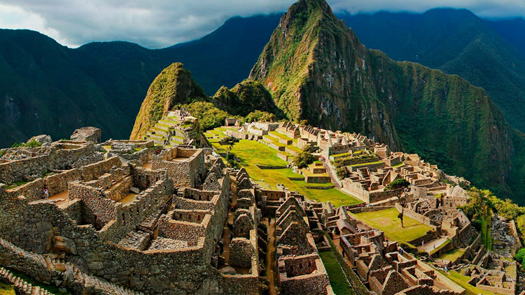Unit 5: Lesson 4
Unit 5: Lesson 4

Overview
 Hola! Como estas?
Hola! Como estas?
In this last Unit Lesson, we are going to explore some of the Hispanic-speaking cultures through one of the 21 Spanish-speaking countries. For this lesson, you will need speakers or headphones. Let's begin! Vamos a comenzar!
GEOGRAPHY
Peru is the third largest country in South America, after Brazil and Argentina. It is made up of a variety of landscapes, from mountains and beaches to deserts and rainforests. Most people live along the coast of the Pacific Ocean, where the capital, Lima, is located. Form of Government: Constitutional republic Capital: Lima Population: 28,302,603 Official Languages: Spanish, Quechua Along Peru's west coast is a narrow strip of desert 1,555 miles (2,500 kilometers) long. Ancient people called the Chimú and the Nasca inhabited this region thousands of years ago. The coastal desert makes up only about 10 percent of Peru but is home to more than half of Peruvians.
NATURE
Because it has many different ecosystems, Peru is home to a wider variety of plants and animals than most other countries on Earth. For many reasons, Peruvians have not had as much of an impact on their natural world as many different countries, and many of these ecosystems have been undisturbed. A 250-acre (100-hectare) plot of Peruvian rainforest is home to more than 6,000 kinds of plants! Hundreds of species are only found in the Amazon. Peru has created particular forest areas called reserves to protect these plants and animals.
HISTORY
Peru is an ancient country. The earliest inhabitants arrived there about 15,000 years ago. Societies emerged on the west coast more than 5,000 years ago and began to spread inland. These included the Chavín, the Moche, and the Nasca. One of the most essential Peruvian cultures was the Inca, who lived in Peru around 600 years ago. Their capital, Cusco, is still a major city today. The Inca also built Machu Picchu, a famous and mysterious ancient city in the Andes. They thrived for centuries before being conquered by the Spanish in 1532.
PEOPLE AND CULTURE
The people of Peru are a mix of many different cultures, including Indians, Spaniards, and other Europeans, descendants of African slaves, and Asians. Until recently, most people lived in the countryside. But now, more than 70 percent live in cities. Most Peruvians follow the Catholic religion introduced by the Spanish. GOVERNMENT AND ECONOMY Peru is a constitutional republic with a president, a congress, and a supreme court. Peruvians are required to vote by law. Presidents serve five-year terms and can only be elected twice in a row.
Details and Video
Official Name: Republic of Peru
Form of Government: Constitutional republic
Capital: Lima
Population: 28,302,603
Official Languages: Spanish, Quechua
In the following video, we will explore the Peruvian culture and beautiful natural resources. As you watch the video, please take some notes you can add later to your journal.
